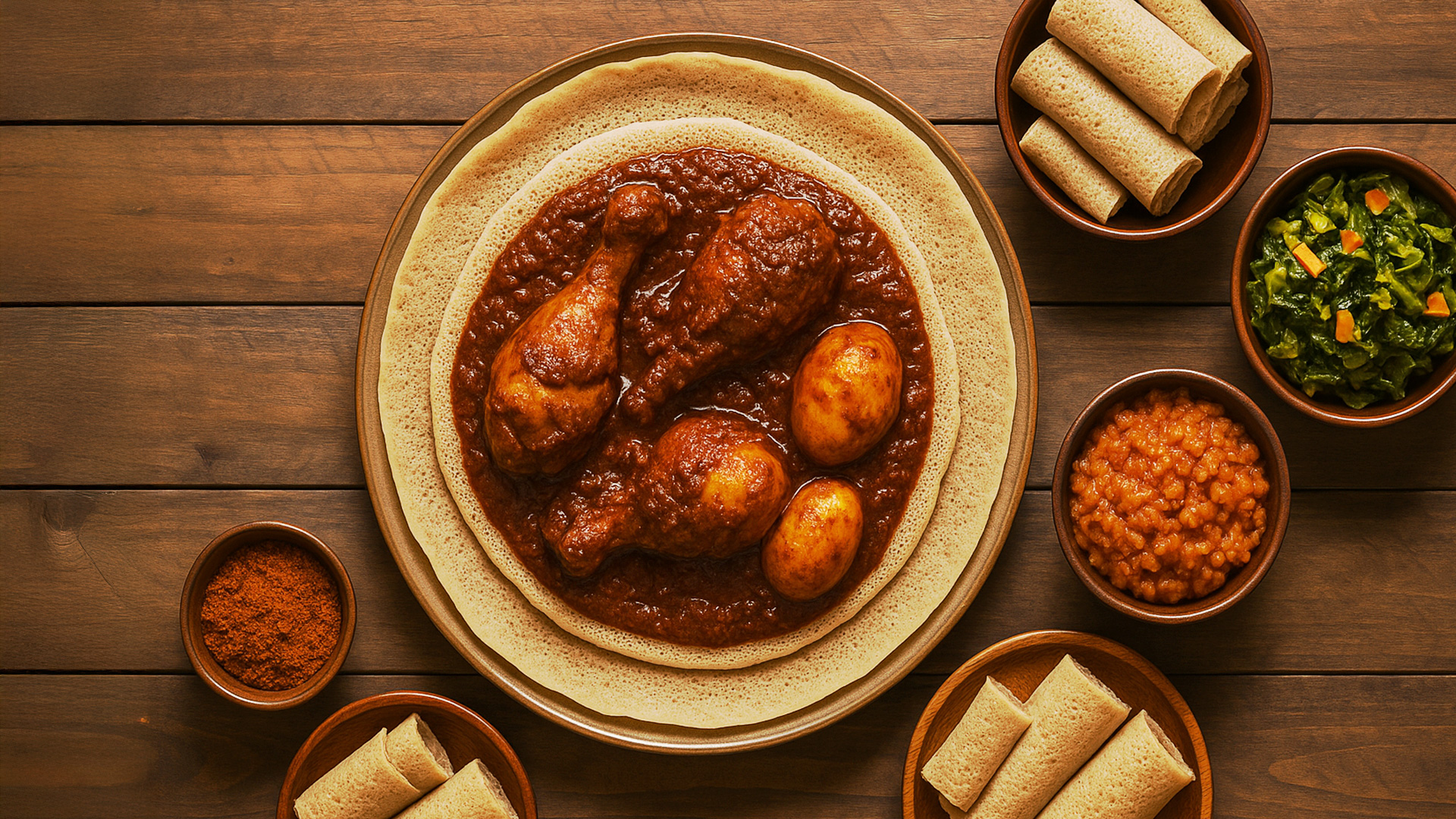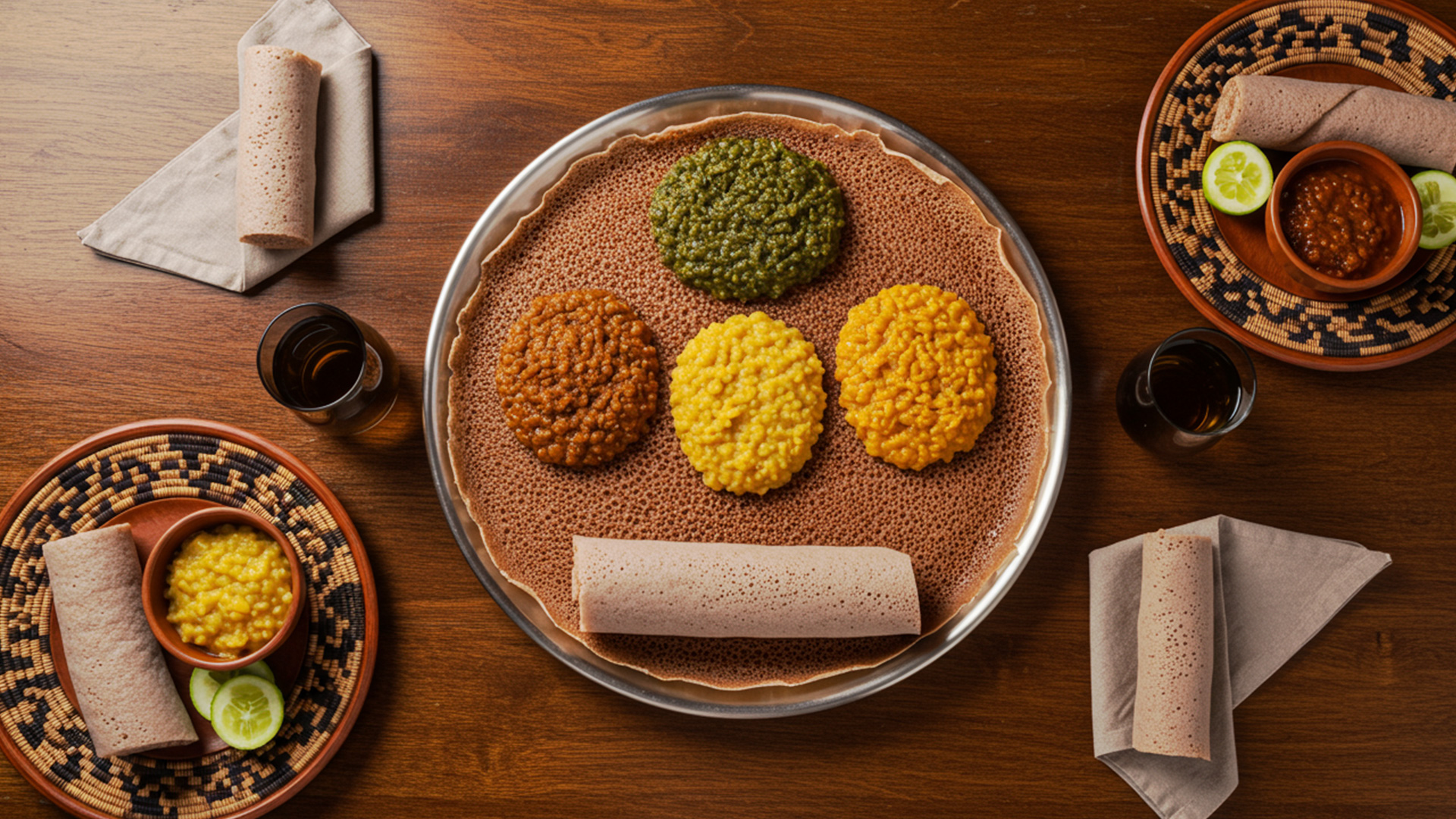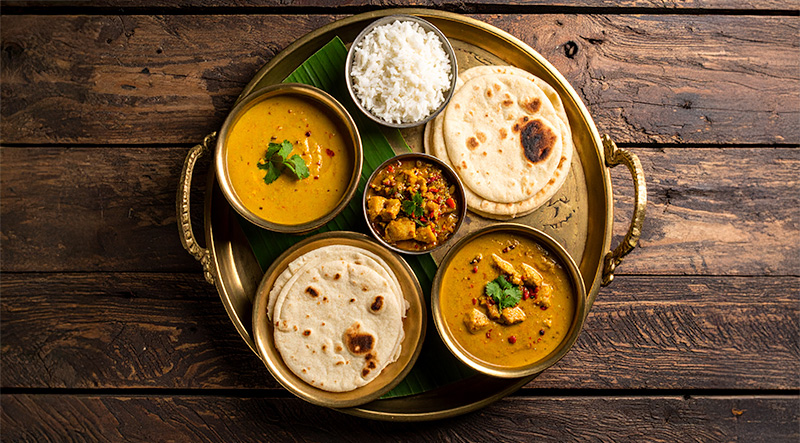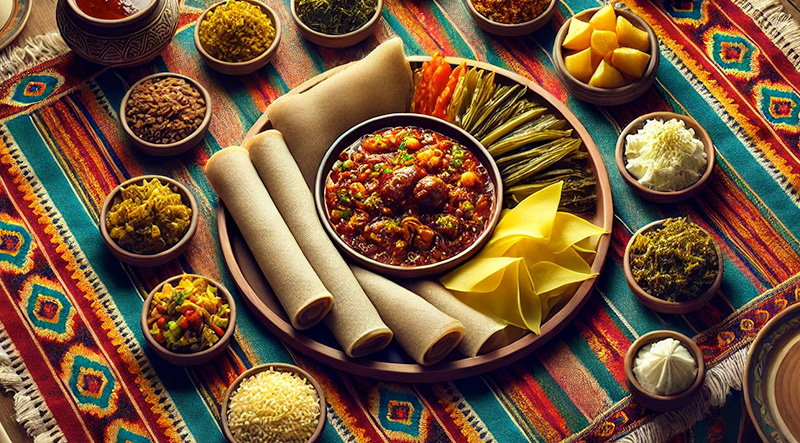The national dish of Ethiopia is Injera with Doro Wat, a flavorful and culturally significant meal. Injera, a spongy, sour flatbread made from teff flour, serves as both a base and utensil, while Doro Wat is a rich, spicy chicken stew made with berbere spice, spiced clarified butter (niter kibbeh), onions, and hard-boiled eggs. Often served during holidays and special occasions, this dish reflects Ethiopian traditions of communal eating and hospitality, offering a perfect blend of bold flavors and cultural pride. Read More...
The History of Injera with Doro Wat – Ethiopia’s National Dish, A Meal That Tells a Story:
Few dishes capture the essence of a nation like injera with doro wat does for Ethiopia. With its bold flavors, communal nature, and deep cultural symbolism, this iconic pairing is far more than food—it’s a reflection of Ethiopia’s history, hospitality, and identity. Injera, the spongy sourdough flatbread, serves as the base for doro wat, a richly spiced chicken stew made with berbere and niter kibbeh. Together, they form the centerpiece of Ethiopian cuisine and are enjoyed in homes, religious feasts, and celebrations across the country.
Ancient Origins of Injera:
Injera’s roots stretch back thousands of years, closely tied to teff, an ancient grain indigenous to the Ethiopian highlands. Archaeological findings suggest that teff has been cultivated in Ethiopia for over 5,000 years. It thrives in the country’s high altitude and arid conditions, making it a staple crop. Fermented for several days, teff flour transforms into a naturally leavened batter, which is then cooked on a flat griddle called a mitad to form the soft, slightly tangy injera. Its unique texture and sour flavor became the foundation of Ethiopian meals, serving as both plate and utensil in the traditional practice of communal dining.
The Rise of Doro Wat:
Doro Wat—literally “chicken stew”—emerged as a dish of celebration and ceremony. While stews, or wats, have long been a part of Ethiopian cooking, doro wat is considered the most elaborate and prestigious. Preparing it is labor-intensive: onions are slow-cooked for hours until they caramelize, then infused with fiery berbere spice blend and enriched with niter kibbeh, a spiced clarified butter unique to Ethiopia. Bone-in chicken pieces and hard-boiled eggs are then simmered in the sauce until tender and flavorful.
Historically, chicken was a luxury item, often reserved for major holidays such as Meskel (the finding of the True Cross), Genna (Ethiopian Christmas), and Easter. Doro wat became the preferred dish during these occasions, reflecting both celebration and respect. In many Ethiopian households, it’s traditional for the woman of the house to serve the first piece of injera with doro wat to a guest or elder—an act of deep hospitality.
More Than a Meal: Culture and Unity:
One of the most defining aspects of injera with doro wat is its communal nature. Meals are traditionally served on a large round platter, with portions of injera layered beneath various stews, including doro wat. Diners gather around and eat with their hands, tearing pieces of injera to scoop up the richly spiced meat and sauce. This method of sharing not only deepens the connection between people but also reinforces Ethiopia’s deeply held cultural values of community and togetherness.
A Dish Across Borders:
As Ethiopians migrated across the world, they carried their food culture with them. Today, injera and doro wat are served in Ethiopian restaurants and homes throughout North America, Europe, the Middle East, and beyond. Teff has gained global recognition for its health benefits—being gluten-free and high in iron and protein—bringing injera into the spotlight even outside Ethiopian communities.
A Timeless Symbol:
Injera with doro wat remains an enduring symbol of Ethiopia’s culinary legacy. From ancient traditions to modern celebrations, it continues to tell the story of a resilient people, their land, and their love of flavorful, shared food. Whether served at a grand holiday feast or a quiet family dinner, this national dish remains a delicious bridge between past and present.
Begin the injera batter (Day 1):

Prep chicken for doro wat (same day or next):
Caramelize the onions:

Build the stew base:
Simmer the chicken:

Finish the doro wat:
Finish and cook injera (Serving Day):

Serve Ethiopian-style:
Enjoy a true taste of Ethiopia, where the tangy sponge of injera meets the bold, spicy depths of doro wat in a feast meant for sharing.
The total preparation and cooking time for Injera with Doro Wat is approximately 2 to 3 days, though active cooking takes about 2 to 2.5 hours. Making injera traditionally requires 24 to 72 hours of fermentation, with about 30 minutes of active prep and cooking per batch. Doro Wat takes around 2 hours, including 20–30 minutes to caramelize onions, another 60 minutes to simmer the chicken in the spicy sauce, and additional time to boil eggs and combine ingredients. While the process is time-intensive, much of it is passive, and the final meal is a richly rewarding expression of Ethiopian culinary tradition.
A single serving of Injera with Doro Wat, based on the recipe provided, contains approximately 500–650 calories. The injera (1 large piece) contributes about 150–200 calories, mostly from teff flour, which is high in complex carbohydrates, fiber, and protein. The Doro Wat portion—typically one chicken leg or thigh, one hard-boiled egg, and a generous ladle of the spicy berbere-onion sauce—adds around 350–450 calories, depending on the amount of clarified butter (niter kibbeh) used. Additional garnishes or extra injera may slightly increase the calorie total, but overall, it's a balanced and nutrient-rich traditional Ethiopian meal.







